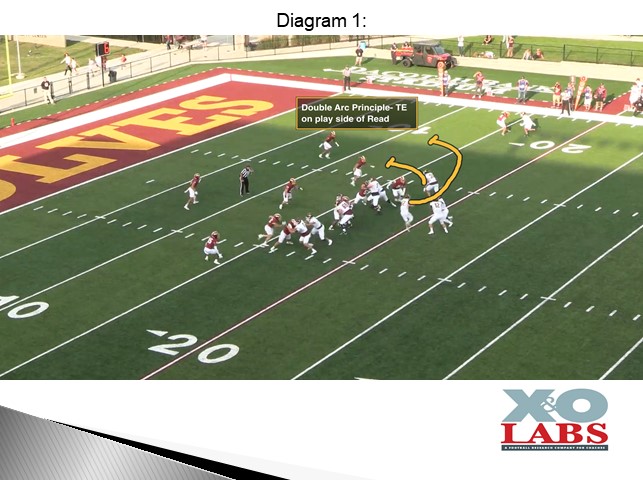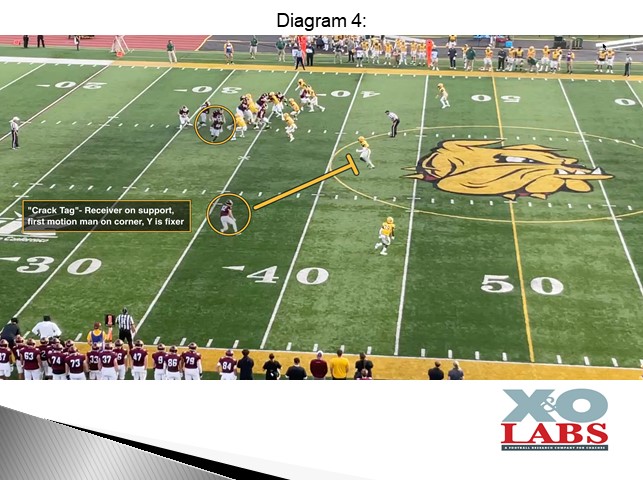By Mike Kuchar with Chase Vogler
Offensive Coordinator/Wide Receivers Coach
University of Minnesota Duluth
Twitter: @CoachVogler
Minnesota Duluth is in its third year of developing the quarterback run package, but it may be indisputable that this season was it’s strongest. The Bulldogs leaned on quarterback runs to generate over 240 yards per game on the ground and its quarterback had many of those by himself. The Bulldogs QBR package is versatile enough to have rules for every front and often times Coach Vogler trusts his quarterback to make these changes at the line of scrimmage. We’re going to dive into the Bulldogs two most efficient QB run schemes- the zone read bluff and G lead- and why they have been so efficient.
Zone Bluff Concept:
Duluth is traditionally a 12 and 13 personnel outfit, so it made sense to keep those heavier groupings when designing the complementary QB runs. When Coach Vogler designs his zone read principles, he chooses to use tight ends to block on the perimeter for the quarterback keep. And instead of using tight zone blocking, the Bulldogs use the mid-zone variety and read the C gap defensive end. The running back is taught to track the inside foot of the play side Tackle. “We used to track the inside foot of the Guard, but it was too tight,” said Coach Vogler. “We wound up banana-ing the path.”
Double Swipe Principle:
One of the innovations that Duluth uses in its zone bluff concept is a double swipe concept- having two blockers block for the QB on the pull read. It’s helped in generating over 14 yards a game this season on the concept. Modeled after what Utah was doing, there will be two blockers at the point of attack for the quarterback. One is a jet motion element and one is an off-line tight end. “When you present jet motion and a swiper you are going to freeze linebackers,” said Coach Vogler. “It’s difficult for defensive ends to see the ball through all that movement. But the ideal snap point should be on the backside Tackle.”
These players are responsible for both the force defender and the -1 defender in the count, but Coach Vogler and his staff will vary their responsibilities. So, he had to be deliberate in teaching which blocker was the lead blocker and which was the wrapper- or what Coach Vogler calls the “fixer.” Duluth is a huddle, longer verbiage based operation so these words are all communicated in the play call.
- “Plane” Tag- This tells the jet motion man there is no mesh to the QB; the motion clears to the other side of the formation.
- “Jet” Tag- This tells the jet motion man he will mesh with the QB and is part of the read element of the concept. These are clearly used in jet read concept, which although they are part of the offensive menu at Duluth, are not detailed in this clinic report.
- “Brake” Tag- This tells the jet motion man there is no mesh to the QB; but he is in a block scenario on the edge to block for the quarterback on the pull read.
While the terminology is one thing, making sure both blockers handle their correct responsibilities is a whole other teaching point.
For example, if the tight end is aligned to the side of the read, he will block support while the jet motion man is the “fixer.”


If the Tight End is on the backside of the read, the motion man is on alley support while the tight end is the “fixer” blocking the second threat.

Coach Vogler will also build in “crack” calls which tells the single receiver to cracking on the perimeter. This means the motion man is on support (or first threat) while the tight end is the fixer, who will usually block the -1 linebacker to the side of the read or the Will linebacker.










